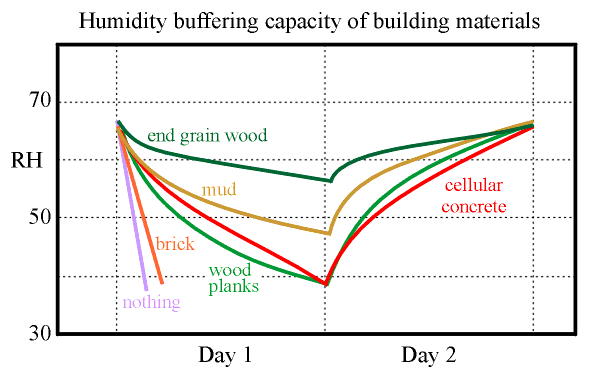
 |
Comparison of the buffer performance of various materials |

This diagram shows the course of the relative humidity in a room which has walls and ceiling of various materials, as 300 mm thick tiles with an impermeable back surface. The tiles cover one square meter per cubic metre of room volume. This is a quite typical ratio of surface area to volume of a room.
The experimental chamber first withdraws water from the air and then adds it to imitate the following scenario:
During day one the house is unoccupied. Water vapour is withdrawn from the room at the rate of 2g/m3/hr. This is what would happen if the weather outside were rather cold and the house had an air change rate of about once per hour. The rapidly descending lines for the unabsorbent room and the brick wall are only drawn for the first few hours, for clarity
During day two the family returns and is busy preparing an evening feast, cooking pasta and then showering, before twenty five guests fill the house, breathe, spill their drinks, and finally leave after taking a mug of steaming hot coffee. They add 2g/m3/hr water vapour.
The clear winner for buffering the climate is a familiar material, wood, used in an unfamiliar way, as blocks sawn across the grain. Mud comes in second and brick in a surprising last place with hardly any buffer capacity at all.
The degree of humidity buffering by this modest amount of wall covering is impressive. It would allow a considerable reduction in the air conditioner capacity for a museum, because the moisture generated by visitors is mopped up by the walls. The intended RH can be re-established overnight. About three quarters of the life of a museum gallery is spent alone with the exhibits, yet the air conditioning is designed for the peak people load.
If one looks now at the details of the curves in the diagram, one notices that after the initial quick response some curves become almost straight. This indicates that the entire thickness of the tile is being used to buffer. The curve for the wooden planks, however, continues to curve round so that at last it overtakes the buffer performance of the cellular concrete. The wooden planks, which should be such a good buffer according to their known water exchange capacity, behave badly in this short test simply because the diffusion of water through the wood is so slow.
The next chapter looks in more detail at the performance of mud, and the chapter after that looks at end grain wood.

This work is licensed under a Creative Commons Attribution-Noncommercial-No Derivative Works 3.0 License.